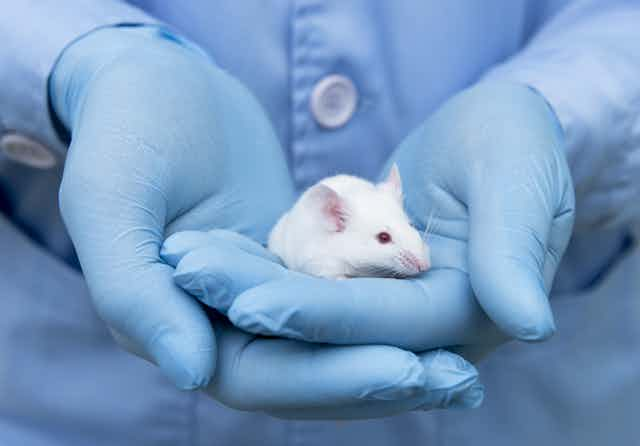If you have ever taken a medicine, then you have benefited from research in animals. But ten years ago, if you looked at a scientific report involving mice or rats, it would probably have used only male animals.
This means that, even now, if you’re a woman and the medicine has only been developed and tested using male animals, we don’t know how that medicine is going to affect you.
Scientists long assumed that females would respond the same way as males in drug trials. But today, that situation is changing. More and more studies use both female and male animals – and new science is emerging about important sex differences as a result.
For example, a growing body of evidence from animal studies is highlighting complex sex differences in rodent brains, relating to their size, shape, and how nerve cells connect with one another.

This article is part of Women’s Health Matters, a series about the health and wellbeing of women and girls around the world. From menopause to miscarriage, pleasure to pain the articles in this series will delve into the full spectrum of women’s health issues to provide valuable information, insights and resources for women of all ages.
You may be interested in:
Five old contraception methods that show why the pill was a medical breakthrough
The orgasm gap and why women climax less than men
So it’s no surprise that research is also increasingly showing sex differences in human medical issues. For example, women are twice as likely as men to be diagnosed with depression, and sex differences are also clear in people’s response to antidepressants. Women have a stronger response than men to selective serotonin reuptake inhibitors (SSRIs), whereas men have a better response to tricyclic antidepressants.
Never assume
Excluding females from research for so long has had worrying consequences for women’s health. One example is adverse drug reactions – the unintended consequences of taking a medicine, which can include things like nausea, headaches, seizures or heart problems.
Women typically have double the risk for adverse drug reactions (although men have increased risks of some side-effects). One reason is that women, on average, are smaller than men, yet the recommended dosage for many medicines is based on men.
For example, women who take beta blockers, used to treat heart problems, have higher concentrations of it in their blood. This is not only because the same amount of drug in a smaller blood volume will give you a higher concentration. Women also metabolise many medicines differently to men, because of sex hormone levels and enzyme activity.
Why were females excluded?
In science, we like to reduce variability as much as possible, to have more confidence that any changes in an animal or human are because of the experimental intervention we have made.
Females were largely excluded from both animal and human clinical trials because of the menstrual cycle. Fluctuating hormone levels make data difficult to interpret, results more variable, and research more expensive. While males have the same sex steroid hormones, female hormone levels rise and fall. This can impact brain function and behaviour as well as female response to medication.
However, the rodent oestrous cycle is much shorter than in women, only four or five days long – and research over the last decade has shown that female rat behaviour is not more variable as a result.

In part, the male-centric approach to clinical human trials was also because women of child-bearing age could be pregnant and not yet know it. The thalidomide tragedy fed into this mentality. Thalidomide was developed in the 1950s as a sedative and became a popular treatment for morning sickness – but the drug had not been tested on pregnant animals or humans.
Doctors soon realised thalidomide was linked to developmental abnormalities in children born to mothers taking the drug. But it was too late for the estimated 10,000 infants worldwide born with underdeveloped legs and arms, and other birth defects.
Are things getting better?
There is a growing field of research looking at the interaction between medicines and the menstrual cycle, changes during pregnancy, and hormonal contraception. For example, some anti-epileptic drugs can reduce the effectiveness of hormonal contraception, while hormonal contraception can reduce the effectiveness of some anti-epileptic drugs to control seizures. But the many years that females were excluded from studies means there is still so much we don’t know.
Women were only legally required to be included in clinical trials in the 1990s in the US. Some 30 years later, research shows that about half of research participants in clinical studies funded by the National Institutes of Health (NIH), the American medical research agency, are now women.
These policies are also evolving to integrate both biological sex (genetically defined) and gender (a person’s self-identity) into the design, analysis and reporting of clinical research. Many scientific journals are also joining the drive to only publish studies that have considered sex in the design, analysis and reporting.
Meanwhile, it has taken a very long time for female mice to be part of the research picture. In 2014, the NIH, one of the largest funders of medical research in the world, announced that all grant applications needed to include a balance of male and female cells and animals. This policy has since been taken up by major research funders in other countries, such as the Canadian Institutes of Health Research and the European Commission.
Change takes time. Timescales vary dramatically, but it often takes 10-15 years to develop a new medicine. Next there are the clinical trials, which can take a long time depending on the difficulty of recruiting participants.
We are moving to an era of personalised medicine, where medicines can be prescribed on the basis of an individual diagnosis, with targeted interventions based on understanding how an individual patient’s genomes (set of DNA instructions) affect treatment response. But women will miss out on many of the benefits if we don’t understand exactly how the drug they are prescribed affects females.


